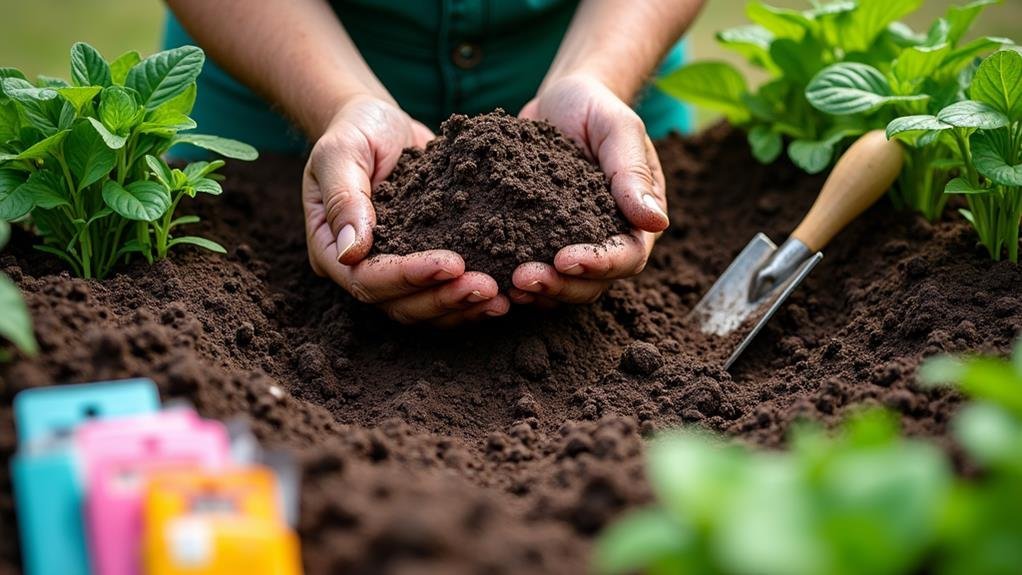When it involves preparing your home garden, understanding your soil is essential for successful growth. You need to assess its texture and organic matter content, but that's just the start. Testing pH levels and choosing the right amendments can greatly impact your garden's health. You'll also want to take into account techniques like crop rotation and cover crops to keep your soil thriving year after year. So, what are the key strategies you should implement first to guarantee your garden flourishes? Let's investigate the top tips that will set you on the right path.
Assessing Your Soil Quality
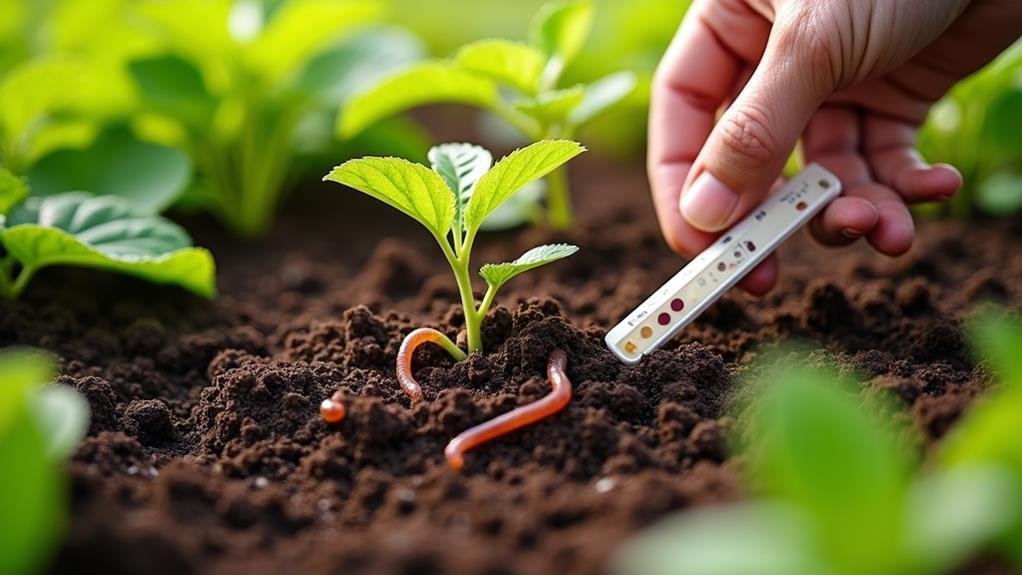
Evaluating your soil quality is essential for a thriving home garden. Start by observing its texture; is it sandy, clayey, or loamy? Sandy soil drains quickly but holds fewer nutrients, while clay soil retains moisture but can become compacted. Loamy soil strikes a balance, offering good drainage and nutrient retention.
Next, check for organic matter, which enriches the soil. You can do this by digging a small hole and examining the top few inches. If you see rich, dark soil full of earthworms, you're likely on the right track.
Don't forget to assess your soil's drainage. When you water your garden, does the water pool or soak in quickly? Poor drainage can lead to root rot, while overly dry conditions can stunt plant growth.
Testing Soil Ph Levels
Regularly testing your soil's pH levels is essential for ideal plant growth. The pH scale ranges from 0 to 14, with 7 being neutral. If your soil's pH is below 6.0, it's considered acidic, while above 7.0 is alkaline. Most plants thrive in slightly acidic to neutral soil (around 6.0 to 7.0).
You can test your soil's pH using a simple kit from your local garden center, or you might opt for a professional lab analysis for more accurate results. Collect samples from various spots in your garden to get a representative reading. Mix these samples and follow the kit's instructions carefully.
Once you get your results, you can better understand what adjustments your soil needs. For example, if your soil is too acidic, you might consider adding lime to raise the pH. Conversely, if it's too alkaline, incorporating sulfur can help lower it.
Adding Organic Matter
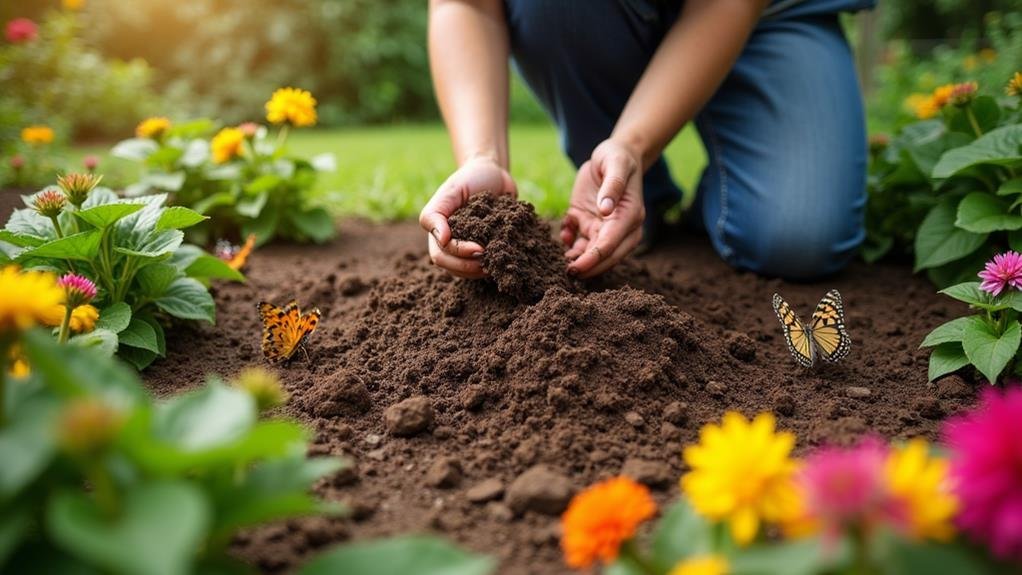
Once you've tested your soil's pH and identified its composition, the next step is adding organic matter to improve its quality. Organic matter, like compost or well-rotted manure, enriches your soil, enhancing its structure and fertility. It helps retain moisture, promotes healthy microbial activity, and provides essential nutrients for your plants.
To get started, choose a high-quality compost or create your own by combining kitchen scraps and yard waste. Aim for a ratio of about 25-30% organic matter to your existing soil. Spread the organic material evenly across your garden bed and mix it in well, ensuring it integrates thoroughly with the soil.
Don't forget to reflect on timing! Adding organic matter in the fall allows it to break down over the winter, while incorporating it in spring can give your garden an early boost.
You might even opt for a layer of organic mulch on top to suppress weeds and retain moisture.
Choosing the Right Mulch
In relation to choosing the right mulch for your garden, a variety of options can improve both aesthetics and functionality. Organic mulches, like wood chips, straw, and grass clippings, enrich the soil as they break down, providing nutrients to your plants. They also help retain moisture, which is essential during dry spells.
On the other hand, inorganic mulches, such as stones or plastic, offer durability and weed suppression but won't improve soil quality. When deciding, consider your garden's needs. If you're growing flowers, colorful bark chips can add visual appeal while regulating temperature.
For vegetable gardens, opt for organic materials that can be tilled back into the soil later. Think about your local climate, too. In hot areas, lighter-colored mulches reflect sunlight, helping to keep your soil cool. In cooler regions, darker mulches absorb heat, promoting growth.
Don't forget about maintenance—some mulches need replenishing more often than others. Ultimately, the right mulch can be a game-changer for your garden, so choose wisely. With the right selection, you'll create a thriving environment for your plants while improving your garden's overall look.
Tilling Techniques
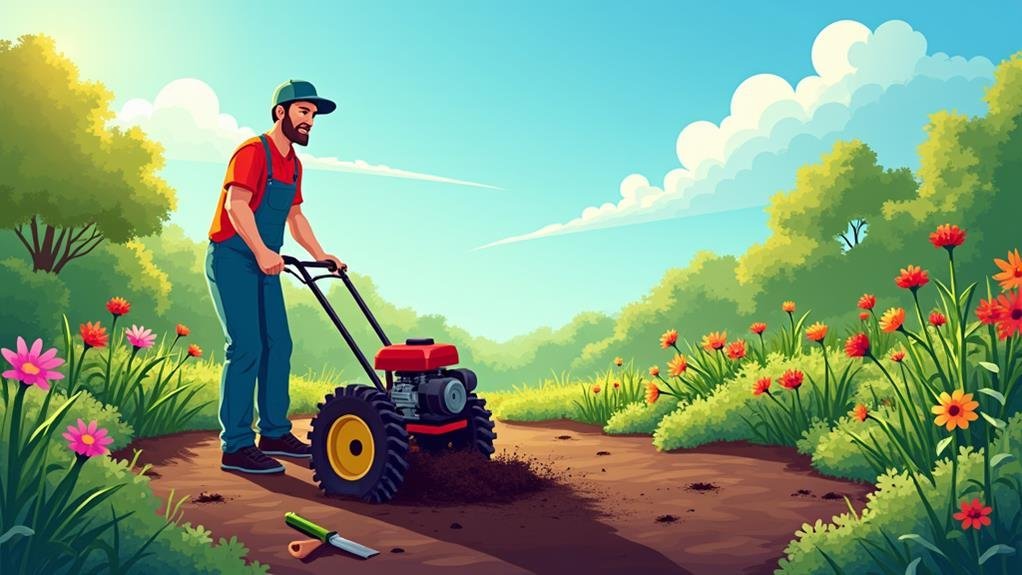
Choosing the right mulch lays the groundwork for healthy soil, but tilling techniques play an essential role in preparing your garden for planting. Tilling helps aerate the soil, break up compacted layers, and mix organic matter into the ground.
Start by determining the size of your garden; for small plots, a hand tiller or garden fork works well, while larger areas might require a rototiller.
When you till, try to do it when the soil is slightly moist but not soggy. This guarantees you won't compact it as you work. Aim to till to a depth of 6 to 12 inches, depending on what you're planting. Remember, the goal is to incorporate any organic material, like compost or aged manure, to enrich the soil.
Be cautious, though—over-tilling can disrupt soil structure and harm beneficial organisms. It's often best to till only once or twice a year.
After tilling, level the soil with a rake. This step helps create a smooth surface for planting. With the right tilling techniques, you're well on your way to a thriving garden!
Managing Soil Moisture
While you may be enthusiastic to plant your seeds, managing soil moisture is essential to ensuring your garden thrives.
Start by understanding your soil type, as this affects how it retains water. Sandy soils drain quickly, while clay soils hold moisture. You'll want to tailor your watering schedule accordingly.
Check the moisture level regularly by sticking your finger about an inch into the soil. If it feels dry, it's time to water.
When you do water, aim for deep, infrequent watering sessions rather than shallow, frequent ones. This encourages roots to grow deeper, making your plants more resilient.
Mulching is another great way to manage moisture. Applying a layer of organic mulch helps retain water, regulates soil temperature, and reduces weed competition.
Just be sure not to pile it against plant stems, as this can cause rot.
Utilizing Cover Crops
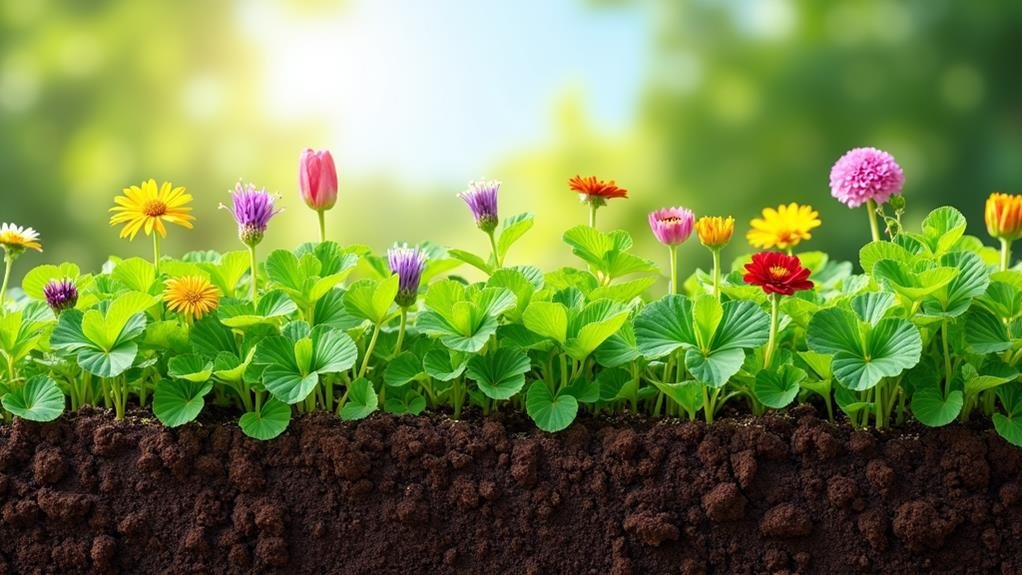
Cover crops can be a game changer for your home garden, offering numerous benefits that improve soil health and fertility. By planting these crops during off-seasons, you can prevent soil erosion, suppress weeds, and boost nutrient levels in the soil.
They're like a protective blanket for your garden, keeping things cozy while also working hard underground.
Common cover crops include clover, rye, and vetch. Each variety brings unique advantages; for instance, clover fixes nitrogen in the soil, which is essential for plant growth.
When you till these crops back into the soil, you're adding organic matter that enhances soil structure and moisture retention.
Make certain to choose cover crops that suit your climate and soil type. Planting them in the fall or early spring guarantees they'll have enough time to grow.
Just remember to cut them down before they go to seed, or you might end up with a surprise crop you didn't plan for!
Incorporating cover crops into your gardening routine can lead to healthier plants and a more productive garden.
Implementing Crop Rotation
Implementing crop rotation is an effective strategy to improve soil health and boost your garden's productivity. By changing the types of crops you plant in specific areas each growing season, you help break pest and disease cycles, as many pests and diseases are crop-specific.
This simple practice also augments nutrient availability in your soil, as different plants absorb and replenish various nutrients.
Start by grouping your plants into families, such as legumes, brassicas, and nightshades. Rotate these families each year to prevent depleting specific nutrients and to promote a balanced soil ecosystem.
For instance, if you planted tomatoes (a nightshade) this year, try planting beans (a legume) the next year. Beans naturally fix nitrogen in the soil, which benefits subsequent crops.
Don't forget to keep track of your planting schedule, as consistency is key for effective rotation. You might even consider using a garden journal to note what you planted and when.
Incorporating Soil Amendments
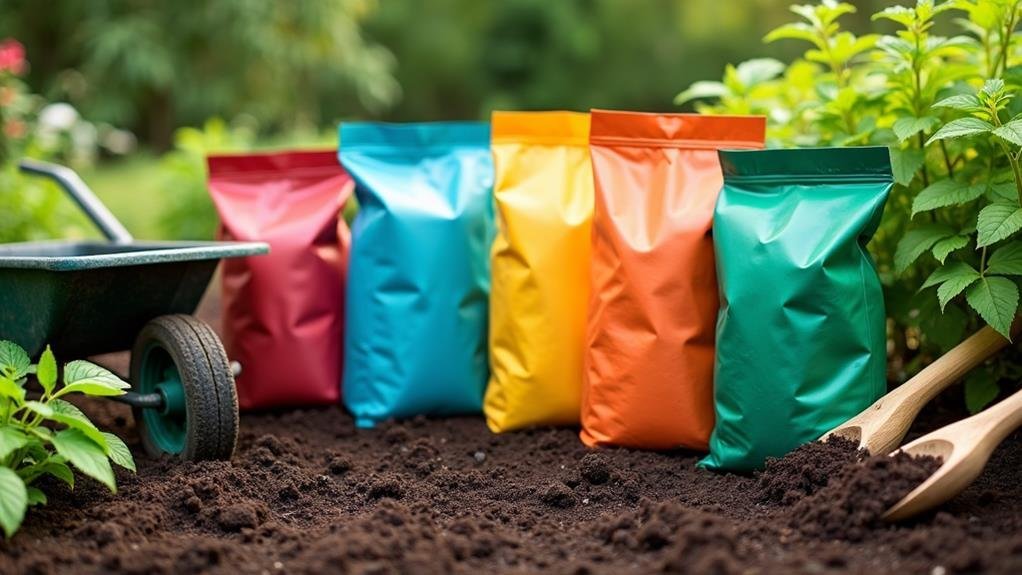
After establishing a solid crop rotation plan, the next step to improve your garden's productivity is incorporating soil amendments. These amendments improve soil structure, fertility, and overall health, giving your plants the best possible growing conditions.
Start by testing your soil, which will help you determine its pH and nutrient levels. Based on the results, you can choose the right amendments.
Organic matter, like compost or well-rotted manure, is a fantastic choice. It enriches the soil, improves drainage, and encourages beneficial microorganisms. Just mix it into the top few inches of soil before planting.
If your soil lacks specific nutrients, consider adding bone meal for phosphorus or greensand for potassium.
Don't forget about mulching! Applying a layer of organic mulch helps retain moisture, suppress weeds, and slowly adds nutrients as it breaks down.
Be mindful not to over-amend, as this can lead to nutrient imbalances. Instead, aim for a balanced approach tailored to your soil's needs.
With the right amendments in place, you'll set the stage for a flourishing garden, where your plants can thrive and produce bountifully.
Creating Raised Garden Beds
Raised garden beds are a fantastic way to maximize your gardening space while improving soil conditions. They provide better drainage, prevent soil compaction, and allow you to control the quality of your soil.
To create your raised beds, start by choosing a sunny location with good access to water. Aim for a height of 12 to 24 inches, which makes reaching plants easier and reduces bending.
You'll need to decide on materials, like untreated wood, bricks, or stone. Make sure to line the bottom with cardboard or landscaping fabric to keep weeds at bay. Once your frame is ready, fill it with a mix of quality soil and compost, ensuring your plants have the nutrients they need to thrive.
Don't forget to design your layout wisely. Consider planting taller crops at the back and shorter ones in front for easy access.
Water your beds regularly, especially during dry spells, and add mulch to retain moisture. With a little effort, raised garden beds not only improve your gardening experience but also yield bountiful harvests.
Conclusion
By following these top 10 soil prep tips, you'll set your home garden up for success. Assess your soil quality, test pH levels, and enrich it with organic matter to promote healthy growth. Don't forget to choose suitable mulch and practice crop rotation for long-term soil health. Whether you opt for raised beds or cover crops, these strategies will help guarantee your garden thrives. Happy gardening, and may your plants flourish! Also, consider implementing efficient compost maintenance tips to further improve the quality of your soil. Regular turning and monitoring of your compost pile will ensure that you have a steady supply of nutrient-rich compost for your garden. Additionally, incorporating diverse plant types and using natural pest control methods can also contribute to the overall health and fertility of your soil. With a little dedication and these soil prep tips, your garden is well on its way to flourishing.

